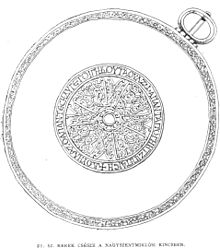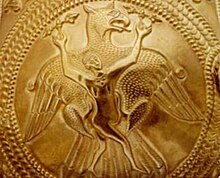| Revision as of 05:44, 30 December 2011 editDaizus (talk | contribs)4,184 edits Undid revision 468480600 by PANONIAN (talk) rv POV pushing and empty threats← Previous edit | Revision as of 06:04, 30 December 2011 edit undoWikiEditor2004 (talk | contribs)Autopatrolled, Extended confirmed users51,646 edits ok, revert once more and you will be reported in incidents treadNext edit → | ||
| Line 16: | Line 16: | ||
| ::(Transliteration: ''bouēla zoapan tesē dygetoigē boutaoul zōapan tagrogē ētzigē taisē''<ref>Francis Dvornik, "Deux inscriptions gréco-bulgares de Philippes", ''Bulletin de correspondance hellénique'', 1928 Vol. 52 no. 52, pp. 125-147 , accessed Oct. 10, 2011</ref>) | ::(Transliteration: ''bouēla zoapan tesē dygetoigē boutaoul zōapan tagrogē ētzigē taisē''<ref>Francis Dvornik, "Deux inscriptions gréco-bulgares de Philippes", ''Bulletin de correspondance hellénique'', 1928 Vol. 52 no. 52, pp. 125-147 , accessed Oct. 10, 2011</ref>) | ||
| The language of the inscription is probably a ]. While there is no consensus as to the meaning of the inscription, there is general agreement that ] are Turkic names or titles, and that they are associated with the title of '']''. There is another inscription in ] and several other very short inscriptions in a ] and also likely to be in a Turkic language, but these are very brief and also have not been deciphered.<ref>András Róna-Tas, ''Hungarians and Europe in the early Middle Ages'' (Central European University Press, 1999; ISBN 9639116483), pp. </ref><ref>Agustí Alemany, "From Central Asia to Balkans: the title *ču(b)-pān" in Christine Allison, Anke Joisten-Pruschke, Antje Wendtland (eds.), ''Daēnā to Dîn: Religion, Kultur und Sprache in der iranischen Welt'' (2009; ISBN 9783447059176), pp. 3-12, p. </ref> | The language of the inscription is probably a ]. While there is no consensus as to the meaning of the inscription, there is general agreement that ] and ] are Turkic names or titles, and that they are associated with the title of '']''. There is another inscription in ] and several other very short inscriptions in a ] and also likely to be in a Turkic language, but these are very brief and also have not been deciphered.<ref>András Róna-Tas, ''Hungarians and Europe in the early Middle Ages'' (Central European University Press, 1999; ISBN 9639116483), pp. </ref><ref>Agustí Alemany, "From Central Asia to Balkans: the title *ču(b)-pān" in Christine Allison, Anke Joisten-Pruschke, Antje Wendtland (eds.), ''Daēnā to Dîn: Religion, Kultur und Sprache in der iranischen Welt'' (2009; ISBN 9783447059176), pp. 3-12, p. </ref> | ||
| ==Connections== | ==Connections== | ||
Revision as of 06:04, 30 December 2011


The Treasure of Nagyszentmiklós or Treasure of Sânnicolau Mare is an important hoard of twenty-three early medieval gold vessels, in total weighing 9.945 kg, found in 1799 near the town then known as Nagy Szent Miklós or Groß-Sankt-Niklaus (Romanian: Sânnicolau Mare) in northern Banat (then part of the Torontal County within the Habsburg Kingdom of Hungary in the Habsburg Empire, today in Timiş County in western Romania, near the border with Hungary). After the excavation, the treasure was transferred to Vienna, the capital of the empire, where it has been ever since, and is on display at the Kunsthistorisches Museum. A wide range of views continue to be held as to the dating and the origins of the styles of the pieces, and the context in which they were made, which may well vary between the pieces. Unusually, the inscriptions on some pieces have if anything increased the complexity of the arguments rather than reduced them. Recently, Romania have issued requests to the Austrian government for its repatriation.
Description
The treasure, consisting of twenty-three gold vessels and variously dated from the 6th to the 10th century, was found in 1799 in the vicinity of Sânnicolau Mare. The figure of the "victorious Prince" dragging a prisoner along by his hair (see figure on the right), and the mythological scene at the back of the golden jar, as well as the design of other ornamental objects, show close affinities with finds at Novi Pazar, Bulgaria and at Sarkel, Russia. Stylistically, Central Asian, Persian-Sassanid and Byzantine influences are predominant.
Inscriptions
Main article: The Buyla inscriptionOn one of the vessels in the hoard there is an inscription written in the Greek alphabet which reads:
- BOYHΛA.ZOAΠAN.TECH.ΔYΓΕTOIΓH.BOYTAOYΛ.ZΩAΠAN.TAΓPOΓH.HTZIΓH.TAICH
- (Transliteration: bouēla zoapan tesē dygetoigē boutaoul zōapan tagrogē ētzigē taisē)
The language of the inscription is probably a Turkic language. While there is no consensus as to the meaning of the inscription, there is general agreement that Buyla and Butaul are Turkic names or titles, and that they are associated with the title of župan. There is another inscription in Greek language and several other very short inscriptions in a runiform script and also likely to be in a Turkic language, but these are very brief and also have not been deciphered.
Connections



Avars
Scholars have connected the treasure with the Avar khaganate. The newest researches show direct connections to Avar origin.
Slavs
According to interpretation of the inscription on one of the vessels, this inscription was written by a people whose local leaders had Turkic names and bore Slavic titles (i.e. the title of župan).
Magyar and Bulgar
As noted above, close affinities have been recognized between the Nagyszentmiklós material and that found at Novi Pazar and in Khazar. Archaeologists in both Hungary and Bulgaria consider these affinities to support theories of ancient migration between regions. Both were allied with Khazars for a period. The treasure gives some idea of the arts practised within the First Bulgarian Empire, Hungarian and Khazar states. According to professor Nykola Mavrodinov (based on Vilhelm Thomsen), the script on vessel number 21 is in Bulgar, written with Greek letters, surrounding a cross, and reads, “Boyla Zoapan made this vessel. Butaul Zoapan intended it for drinking.”
Khazar
One school of Hungarian archaeologists maintains that the tenth-century gold and silversmiths working in Hungary were Khazar. When Magyars migrated to Pannonia in 896, some Khazar tribes, known as the Khavars, came with them to their new homes. The Khavars were skilled gold and silversmiths.
Persian
Khazar art is believed to be modelled on Persian-Sassanide art patterns. The Soviet archaeologist O. H. Bader emphasized the role of the Khazars in the spread of Persian-style silver-ware towards the north. Some of these works may have been re-exported by the Khazars, true to their role as middlemen; others were imitations made in Khazar workshops - the ruins of which have been traced to near the ancient Khazar fortress of Sarkel. The Swedish archaeologist T. J. Arne mentions ornamental plates, clasps and buckles found as far as Sweden, of Sassanide and Byzantine inspiration, manufactured in Khazaria or territories under their influence. Thus, the Khazars, Magyars and Bulgars could have been intermediaries in the spreading of Persian-Sassanide art in Eastern Europe.
Central Asian
Several elements of the Treasure of Nagyszentmiklos have Central Asian counterparts. One is the scene of the divine Garuda bird's lifting up a human body. This motif can be found all over Central Asia, India and Siberia. The motif of an animal drinking from the cup also occurs throughout Eurasia from China, through Siberia, to Hungary. The image of the nautilus shell in the set may relate to India, where the animal is native to the Indian Ocean. This relation goes back to the Hephthalites, the white Huns who ruled during the fourth and fifth centuries in Gujarat, Rajastan.
See also
References
- Franz Heinrich Ungewitter, Europe, past and present: a comprehensive manual of European geography and history (1850), p. 528
- Das goldene Reich der Pamir-bulgaren an Donau und Wardar, Hanswilhelm Haefs, BoD – Books on Demand, 2009, page 7.
- Official description at Kunsthistorisches Museum Vienna
- Banatenii spera sa recupereze Tezaurul de la Sannicolau. Retrieved September 02, 2008.
- Comorile Banatului se intorc acasa. Retrieved September 02, 2008
- László Gy., Rácz I. (1986): A Nagyszentmiklósi kincs Treasure of Nagyszentmiklos. Helikon, Budapest
- Francis Dvornik, "Deux inscriptions gréco-bulgares de Philippes", Bulletin de correspondance hellénique, 1928 Vol. 52 no. 52, pp. 125-147 , accessed Oct. 10, 2011
- András Róna-Tas, Hungarians and Europe in the early Middle Ages (Central European University Press, 1999; ISBN 9639116483), pp. 131-132
- Agustí Alemany, "From Central Asia to Balkans: the title *ču(b)-pān" in Christine Allison, Anke Joisten-Pruschke, Antje Wendtland (eds.), Daēnā to Dîn: Religion, Kultur und Sprache in der iranischen Welt (2009; ISBN 9783447059176), pp. 3-12, p. 5
- ЗЛАТНОТО СЪКРОВИЩЕ НА БЪЛГАРСКИТЕ KАНОВЕ - анотация на проф. Иван Добрев. Военна Академия "Г. С. Раковски", София.
- Avar goldsmiths’ work from the perspective of cultural history. In: C Entwistle, N Adams, Byzantine goldsmithwork. London: British Museum Press, 2009. p. 62.
- A short essay on the Nagyszentmiklós treasure. in: The Gold of the Avars. The Nagyszentmiklós Treasure. General editor: T. Kovács. Budapest 2002, 57-80.
- Hungarians and Europe in the early Middle Ages: an introduction to early Hungarian history, András Róna-Tas, Central European University Press, 1999, page 132.
- Popoli delle steppe: unni, avari, ungari, 23-29 aprile 1987, Том 2, Presso la sede del centro, 1988, page 503.
- László Gy., Rácz I. (1986): A Nagyszentmiklósi kincs (Treasure of Nagyszentmiklos). Helikon, Budapest
- Dunlop, D. M., "Khazars", in Enc. Judaica, 1971-2 printing.
- Bader, O. H., Studies of the Kama Archaeological Expedition (in Russian, Kharkov, 1953)
- Arne, T. J., "La Su de et l'Orient", Archives d'Études Orientales, 8º. v.8, Upsala, 1914.
- Bálint Cs. (2004): A nagyszentmiklósi kincs. (Treasure of Nagyszentmiklos). Varia Archaeologica Hungarica c. series, XVIa, Budapest
- Bálint Cs. (2000): "Der Schatz von Nagyszentmiklós in der Bulgarischen Archäologischen Forschung", in Acta Archaeologica Academiae Hungaricae, 51. 1999/2000. 1-4. 429-438
Outer references
- Kunsthistorisches Museum, Wien
- http://www.sannicolau-mare.ro/
- On the tresaure of Nagyszentmiklós
- On the treasure